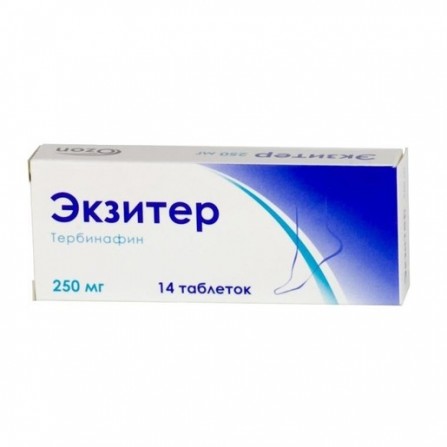Exiter pills coated 250mg N14
Condition: New product
1000 Items
Rating:
Be the first to write a review!

More info
Active ingredients
Terbinafin
Release form
Pills
Composition
Terbinafine (in the form of hydrochloride) 250 mg Auxiliary substances: microcrystalline cellulose, sodium starch glycolate, pregelatinized starch, magnesium stearate, anhydrous colloidal silicon.
Pharmacological effect
Antifungal agent of the allylamines group. It has an effect due to the suppression of squalene epoxidase in the cell membrane of the fungus. This leads to a deficiency of ergosterol and to the intracellular accumulation of squalene, which causes the death of the pathogen cell. It has a fungicidal effect on dermatophytes, mold and some dimorphic fungi, yeast and yeast-like fungi. Some types of yeast fungus can act fungistatically. Active against pathogens of ringworm (Trichophyton / including Trichophyton rubrum, Trichophyton mentagrophytes, Trichophyton tonsurans, Trichophyton verrucosum, Trichophyton violaceum /, also Microsporum canis and Epidermophyton floccosum); yeast-like fungi of the genus Candida (mainly Candida albicans); pathogen multicolor lichen (Malassezia furfur).
Pharmacokinetics
After ingestion is well absorbed from the gastrointestinal tract. Plasma protein binding - 99%. Terbinafine diffuses through the dermal layer of the skin and accumulates in the lipophilic stratum corneum, secreted into sebum, resulting in high concentrations in hair follicles and nails. During the first few weeks after the start of treatment, terbinafine accumulates in the skin and nail plates in concentrations that provide fungicidal action. Metabolized in the liver to form inactive metabolites. Excreted in the urine, mainly in the form of metabolites. T1 / 2 - 17 h.
Indications
For oral administration: fungal skin lesions caused by dermatophytes - trichophytia, athlete, microsporia, fungal nail infections (onychomycosis), candidiasis. For external use: fungal skin lesions caused by dermatophytes, candidiasis; varicolor versicolor.
Contraindications
- Hypersensitivity to any of the components of the drug or to other derivatives of dihydropyridine, other ACE inhibitors; - angioedema in history, including caused by the use of other ACE inhibitors; - hereditary and / or idiopathic angioedema; - hemodynamically significant stenosis of the aorta or mitral valve or hypertrophic obstructive cardiomyopathy; - Severe arterial hypotension (systolic blood pressure less than 90 mm Hg); - cardiogenic shock; - pregnancylactation period; - age up to 18 years; - acute myocardial infarction (during the first 28 days), unstable angina (with the exception of Prinzmetal stenocardia); - lactose intolerance, lactose deficiency and glucose-galactose malabsorption. With care: cerebrovascular diseases (including cerebrovascular insufficiency), coronary artery disease, coronary insufficiency, arterial hypotension, systemic diseases of the connective tissue (including scleroderma, systemic lupus erythematosus), bone marrow hematopoiesis suppression, hyperkalemia, condition after transplantation kidneys, renal and / or liver failure, sick sinus syndrome (severe bradycardia, tachycardia), chronic heart failure, non-ischemic etiology III-IV functional NYHA classifications, heart failure in the decompensation stage, aortic stenosis, mitral stenosis, acute myocardial infarction (after the first 28 days), old age, bilateral stenosis of the renal arteries or arterial stenosis of a single kidney with progressive azotemia, hemodialysis using high-flow dialysis membranes (AN69), azotemia, primary hyperaldosteronism, conditions accompanied by a decrease in circulating blood volume (BCC) (including as a result of diarrhea, vomiting); use in patients on a diet with salt restriction.
Use during pregnancy and lactation
Experience with terbinafine during pregnancy is limited. If necessary, appointments during lactation should decide on the termination of breastfeeding.
Dosage and administration
Inside adults - 250 mg / day in 1 or 2 doses. The duration of treatment depends on the indications and severity of the infection: for skin lesions - 2-4 weeks, for nails - from 6 weeks. up to 4 months or more. Children weighing more than 40 kg - 250 mg / day, 20-40 kg - 125 mg / day, up to 20 kg - 62.5 mg / day. Externally used 1-2 times / day for 1-2 weeks.
Side effects
On the part of the digestive system: nausea, anorexia, mild abdominal pain, diarrhea, disturbances or loss of taste, cholestasis, jaundice, hepatitis. Allergic reactions: skin rash; rarely - arthralgia, myalgia, erythema multiforme, Stevens-Johnson syndrome. CNS: headache. From the side of the hemopoietic system: neutropenia, thrombocytopenia.Local reactions: hyperemia, itching, burning sensation.
Interaction with other drugs
Drugs that induce microsomal liver enzymes increase the clearance of terbinafine; drugs that inhibit microsomal liver enzymes - reduce the clearance of terbinafine.
special instructions
Terbinafine should be used with caution for oral administration in patients with impaired liver and / or kidney function, as well as in elderly people.


